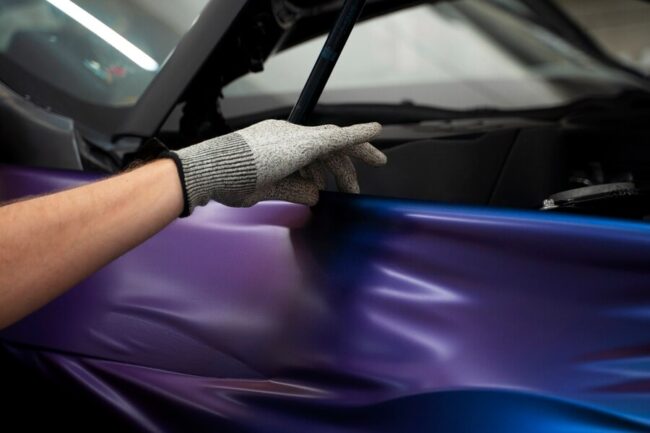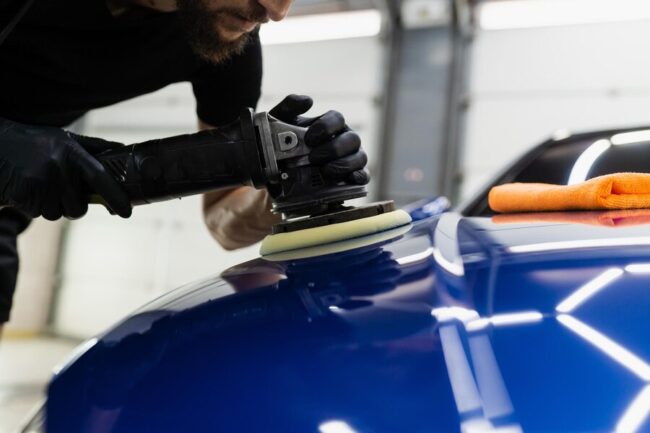In the ever-evolving realm of aerospace technology, where cutting-edge innovation meets the challenges of atmospheric extremes and cosmic exploration, the importance of protective coatings cannot be overstated. Among the array of options available, ceramic coating emerges as a formidable solution, showcasing its prowess in safeguarding both aircraft and spacecraft against the harsh conditions encountered during their journeys. This revolutionary application of ceramics brings forth a paradigm shift in aerospace maintenance, offering unparalleled durability, resistance to extreme temperatures, and enhanced aerodynamic efficiency.
As aerospace engineering continues to push boundaries, ceramic coatings play a pivotal role in enhancing the longevity and performance of vital components. The blog will delve into the intricacies of ceramic coatings, exploring their composition, application processes, and the transformative impact they have on aerospace vehicles. From withstanding the intense heat generated during re-entry to minimizing corrosion caused by atmospheric exposure, the blog will navigate through the multifaceted advantages of ceramic coatings in aerospace applications, shedding light on how these innovative protective layers contribute to the overall reliability and resilience of modern aircraft and spacecraft.
The Evolution Of Aerospace Coatings
Over the decades, the evolution of aerospace coatings has mirrored the dynamic advancements in aviation and space exploration. Initially, the focus was primarily on developing coatings that could withstand the rigors of atmospheric flight, protecting aircraft from corrosion, weathering, and mechanical wear. As technology progressed and the demands of space travel emerged, a new era of coatings emerged, and among them, ceramic coatings stood out for their extraordinary capabilities. These coatings marked a transformative shift by offering unprecedented durability, thermal resistance, and versatility, addressing the unique challenges faced by both aircraft and spacecraft.
The early stages witnessed the prevalence of traditional coatings, often based on paints and polymers. However, as space exploration gained momentum, the need for materials capable of withstanding extreme conditions became apparent. Ceramic coatings, with their ability to endure high temperatures during re-entry and resist corrosive elements encountered in space, became integral to the aerospace industry. The evolution continues with ongoing research and development, pushing the boundaries of material science to create coatings that not only protect but also enhance the overall performance and efficiency of aerospace vehicles. This continuous evolution reflects the relentless pursuit of excellence in aerospace technology and the crucial role that coatings play in ensuring the longevity and functionality of these high-tech vehicles.
Composition Unveiled: What Makes Ceramic Coatings Unique
 Ceramic coatings in aerospace boast a distinctive composition, featuring a blend of inorganic materials subjected to high-temperature processes. Comprising ceramic nanoparticles, binders, and additives, this formula creates a robust layer known for unparalleled resistance to extreme conditions—withstanding elevated temperatures, corrosive environments, and radiation. The incorporation of ceramic nanoparticles ensures exceptional hardness and durability, crucial for aerospace challenges. Moreover, the composition’s low friction coefficient enhances aerodynamic efficiency, reducing drag and optimizing overall performance for both aircraft and spacecraft. This tailored versatility underscores ceramic coatings as indispensable, offering transformative reliability in safeguarding aerospace vehicles against the harshest environmental factors.
Ceramic coatings in aerospace boast a distinctive composition, featuring a blend of inorganic materials subjected to high-temperature processes. Comprising ceramic nanoparticles, binders, and additives, this formula creates a robust layer known for unparalleled resistance to extreme conditions—withstanding elevated temperatures, corrosive environments, and radiation. The incorporation of ceramic nanoparticles ensures exceptional hardness and durability, crucial for aerospace challenges. Moreover, the composition’s low friction coefficient enhances aerodynamic efficiency, reducing drag and optimizing overall performance for both aircraft and spacecraft. This tailored versatility underscores ceramic coatings as indispensable, offering transformative reliability in safeguarding aerospace vehicles against the harshest environmental factors.
Aerodynamic Advantages: Streamlining Flight With Ceramic Coatings
In the dynamic world of aerospace engineering, the application of ceramic coatings emerges as a game-changer in optimizing the aerodynamic performance of aircraft and spacecraft. The molecular composition of ceramic coatings contributes to a streamlined flight experience, enhancing overall efficiency and minimizing drag. These coatings, with their unique properties, play a pivotal role in shaping the future of aviation and space exploration. Here are some key points highlighting the aerodynamic advantages of ceramic coatings:
- Reduced Drag: Ceramic coatings contribute to a reduction in aerodynamic drag, allowing for smoother movement through the air.
- Improved Fuel Efficiency: The streamlined design facilitated by ceramic coatings leads to improved fuel efficiency, a critical factor in long-distance flights or extended space missions.
- Enhanced Speed and Maneuverability: By minimizing air resistance, ceramic-coated surfaces enable increased speeds and improved maneuverability, crucial for both atmospheric and space travel.
In conclusion, the utilization of ceramic coatings in aerospace represents a technological leap forward, optimizing aerodynamics for heightened performance and efficiency. As the industry continues to evolve, these coatings stand as a testament to innovation, shaping the trajectory of future flights and space explorations.
Corrosion Resistance in Aerospace: Ceramic Coatings at the Forefront
In the challenging environment of aerospace, where aircraft and spacecraft are subjected to a myriad of atmospheric elements, corrosion poses a significant threat to structural integrity. Ceramic coatings stand as the vanguard in the battle against corrosion, forming an impermeable barrier that shields aerospace vehicles from the corrosive effects of moisture, oxygen, and other environmental factors. By preventing the penetration of corrosive agents, ceramic coatings not only extend the lifespan of critical components but also contribute to the overall safety and reliability of aerospace systems, ensuring they withstand the rigors of flight and space exploration.
Application Techniques: Precision in Coating for Optimal Protection
The application of ceramic coatings in aerospace demands a meticulous approach, with various techniques employed to ensure precision and efficacy. From thermal spraying to chemical vapor deposition, each method is tailored to the specific requirements of the aerospace component being coated. Precision is paramount, as even a minute deviation in coating thickness or uniformity can impact the protective capabilities of ceramics. By exploring and understanding these application techniques, aerospace engineers can optimize the protective potential of ceramic coatings, enhancing the durability and performance of critical components essential for safe and efficient aerospace operations.
Future Frontiers: Advancements In
The future of aerospace and industrial applications is poised for remarkable advancements in ceramic coating technology. As research and development initiatives continue to push the boundaries of material science, innovative breakthroughs are anticipated to redefine the capabilities of ceramic coatings. These advancements promise to revolutionize the aerospace industry and beyond, offering enhanced performance, durability, and versatility. Key areas of progress include:
 Nanostructuring Techniques: The integration of nanotechnology into ceramic coatings is expected to bring about unprecedented levels of strength, flexibility, and lightweight properties.
Nanostructuring Techniques: The integration of nanotechnology into ceramic coatings is expected to bring about unprecedented levels of strength, flexibility, and lightweight properties.- Self-healing Capabilities: Future ceramic coatings may exhibit self-healing properties, autonomously repairing minor damages and scratches, thereby prolonging the lifespan of coated components.
- Smart Coating Integration: The incorporation of smart technologies could enable ceramic coatings to adapt to changing environmental conditions, providing dynamic protection against diverse challenges such as extreme temperatures and corrosive atmospheres.
- Environmentally Friendly Formulations: Ongoing efforts focus on developing eco-friendly ceramic coating formulations, minimizing environmental impact while maintaining high-performance standards.
These future frontiers in ceramic coating technology are poised to elevate the standards of protection, efficiency, and sustainability across a spectrum of industries, driving the evolution of cutting-edge applications in aerospace and beyond.
Future Frontiers: Environmental Impact – Sustainable Coating Choices for Aerospace
As aerospace technology continues to advance, the quest for sustainable solutions becomes imperative to mitigate environmental impact. The choice of coatings plays a pivotal role in determining the ecological footprint of aerospace activities. Sustainable coating options are emerging as a key focus for the industry, aiming to balance technological progress with environmental responsibility. In the pursuit of greener alternatives, aerospace engineers and researchers are exploring innovative coatings that not only offer robust protection but also adhere to sustainability principles.
- Biodegradable Ceramic Coatings: Research is underway to develop ceramic coatings with biodegradable properties, ensuring minimal environmental impact upon disposal.
- Water-Based Coating Technologies: Efforts are directed towards the formulation of water-based ceramic coatings, reducing the reliance on solvent-based solutions known for their environmental drawbacks.
- Recyclable Coating Materials: Exploring the use of recyclable materials in ceramic coatings to facilitate easier and more environmentally friendly end-of-life disposal processes.
- Reduced Carbon Footprint: Sustainable coatings aim to contribute to a reduction in the overall carbon footprint of aerospace operations, aligning with global efforts to combat climate change.
By embracing sustainable coating choices for aerospace applications, the industry can take significant strides towards a more environmentally conscious future, harmonizing technological progress with ecological responsibility.
Challenges and Considerations: Navigating The Limitations Of Ceramic Coatings
While ceramic coatings offer exceptional protection in aerospace applications, they are not without challenges. Understanding and addressing these limitations is crucial for effectively navigating the complexities of aerospace maintenance and performance optimization.
- Brittleness: Ceramic coatings are inherently brittle, which may pose challenges in situations where flexibility is required. Finding a balance between hardness and flexibility is essential to prevent cracking or delamination under dynamic stress.
- Application Complexity: The application of ceramic coatings demands precision and specialized techniques, often requiring skilled professionals and advanced equipment. This complexity can contribute to increased maintenance costs and time-intensive processes.
- Weight Considerations: Despite their protective properties, ceramic coatings can add weight to aerospace components. Engineers must carefully evaluate the trade-off between protection and increased weight, especially in applications where weight optimization is critical for fuel efficiency and overall performance.
- Temperature Limitations: While ceramic coatings excel in high-temperature environments, extreme temperature fluctuations can still pose challenges. Thermal shock resistance is a consideration, and careful material selection is necessary to ensure optimal performance across a range of conditions.
Navigating these challenges involves ongoing research, technological advancements, and a comprehensive understanding of the specific needs of each aerospace application. As the aerospace industry continues to push boundaries, overcoming these limitations will be instrumental in harnessing the full potential of ceramic coatings for enhanced durability and performance.
In the dynamic world of aerospace, where innovation meets the challenges of extreme environments, ceramic coatings stand out as a formidable protector, enhancing the durability and resilience of vital components in aircraft and spacecraft. As we’ve explored the unique attributes and applications of ceramic coatings, it’s clear they play a pivotal role in shaping the future of aerospace technology. To stay at the forefront of these advancements or for inquiries about ceramic coatings for your aerospace needs, reach out to Quality Auto Glass Tint at 4500 Salida Boulevard, Suite D-E, Modesto, CA, 95368. Call (209) 900-8269 or email support@qualityautoglasstint.com. Our dedicated team is ready to assist you Monday to Saturday, from 9 am to 5 pm. Elevate your aerospace protection with the expertise of Quality Auto Glass Tint today!




